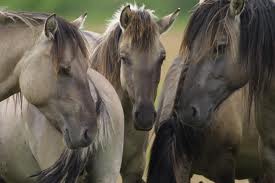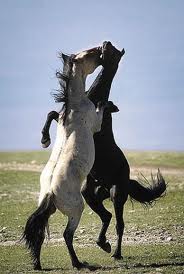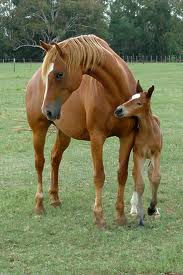|
Equine Behavior
Unique and fascinating, equine behavior characteristics contribute to their development, survival and present-day value as a companion to people. The horse evolved to graze the vast plains, with survival traits that have served it well. Even with domestication it continues to exhibit specific behavior. As a result, humans need to understand horses’ natural behavior or reactions in order to make our interactions with them safer and more rewarding.

Types of Equine Behavior Animal behavioralists have classified the social behavior of horses (and other animals) into the following categories:
•Contactual behavior - behavior related to seeking affection, protection, or similar benefits derived from contact with other animals.
•Ingestive behavior - behavioral activities associated with eating and drinking.
•Eliminative behavior - behavioral activities associated with defecation and urination.
•Sexual behavior - behavior related to mating between males and females.
•Epimeletic behavior - behavior related to giving care and attention, most commonly between a mare and foal but also between other horses (for example,horses standing together under shade or “swishing” flies from one another).
•Allelomimetic behavior - equine behavior related to mimicry, contagious orinfectious behavior such as when one horse copies the behavior of another. If one horse starts running, for example, others are likely to join in. This may be a defense maneuver that is typical of wild horses.
•Investigative behavior - equine behavioral activities associated with curiosity; the exploration of the surroundings or objects. Horses are noted for using all their senses to thoroughly “check out” any new item, horse or place with which they are presented. •Agonistic behavior - equine behavior associated with conflict or fighting, including anger, aggression, submission, and flight from conflict. Sometimes behavioralists separate this equine behavior into two categories - aggression and fearfulness.

•Dominance or submission - equine behavioral activities often referred to as “pecking order”. Dominance hierarchies are extremely prevalent in the social order of horses. Dominance is generally established through agonistic behavior and may be extremely violent (fighting between stallions) or as simple as threatening looks (ears pinned back and squeals). If the lower-ranked (submissive) animal has room to escape,often no contact occurs, and the hierarchy is therefore established or maintained with little or no fighting.
Horse Herd Instinct Domestic horses instinctively want to be in a herd, and readily form herds if maintained on pasture. The desire for contact with other horses can result in horses running back and forth along the fence line or running through the fence if left alone in a field or paddock. Common problems in domestic horses related to their herd instinct may include misbehavior when the handler takes a horse away from the herd or barn, vocalizations and excited inattentive behavior when ridden alone. Stalled horses may exhibit similar behaviors when they do not have visual contact with other horses, or are left alone in the barn. Habitual equine behavior problems such as weaving (exaggerated shifting of the horse’s weight between the forelegs), head tossing (moving the head in a vertical or vertical to horizontal plane often with considerable force) and stall walking (traversing an set area in a specific pattern) also may be caused by separation anxiety in the horse.
Domestic horses have the same response to perceived danger as feral horses. An alarm reaction from one horse in a riding group often results in bolting of other horses in the group. Similarly, if the horses in a riding group are halted when one horse bolts, the bolting horse usually is brought back under control more easily. Horses which avoid being caught by running from the handler can cause the whole herd to begin this irritating behavior. If horses are running, handlers should either wait until they stop running to attempt to catch them or pen the horses in a smaller area where they can be caught easily.
Horse Body Language Understanding equine behavior the and body language of horses can keep you and others safe while working with horses. This article provides some common body language signs and signals, along with descriptions or translations of each. Most of the time, horses use body language to communicate with each other. As horses communicate with each other, they can tell if they are playful, mad, or submissive. The more you are around horses, the better you will understand them and be able to know how they are feeling. Here are some common body language signs in horses and what each means:
Ears Back Usually this means a horse is angry and is threatening another horse. When a horse is mad, the whites of its eyes may be visible and the teeth are usually showing. When a horse's ears are back, it can also mean that the horse is concentrating. If you watch horses that are running or competing, their ears will be back.
One or Two Ears Slightly Back This means the horse is listening to something behind him. If the horse is being ridden, it means the horse is listening to the rider.
Ears Forward If the ears are held forward and the horse is attentive, it means the horse is listening. If the ears are tipped forward and stiff and the nostrils flare, it means the horse is scared or really interested in something.
Tail Swishing Tail swishing usually means that the horse is agitated about something. You need to be cautious, because this can be followed by a kick. Tail swishing warns other horses to back off. There is another kind of swishing, too. Horses swish their tails to keep off flies and other insects. It is important to know the cause of tail swishing.
Bucking Horses will sometimes take off running and bucking across a field. This is a sign that a horse feels good and is in a playful mood. Its ears will be back, and it may grunt and squeal. Bucking can also mean that the horse is frightened. Young horses will often buck with riders the first couple of times they are ridden because they are unsure of the situation. Some horses will get in the habit of bucking because they have learned that they can unseat the rider. Bucking is not a sign of pain. Normally, a horse in pain will not want to move and, when asked, will refuse to move or move more slowly. A horse that is really afraid will not buck. It will rear up or, most likely, run. Remember, horses are flight animals.
Rearing Horses usually rear when they are playing. You will commonly see rearing in foals playing with each other or their dams. However, stallions will rear when they are fighting, and most horses will rear out of fear, especially when there is no escape. Horses that rear habitually or because they are mean are very dangerous to handle or ride.
Horse Fight vs Flight Instinct Horses prefer to flee from danger, if possible. This may be in the form of a total “run off” or the horse that simply does not want to be caught. However, if flight is not an option, horses will fight to protect themselves from a perceived danger. Horses evolved from small mammals whose survival depended on their ability to flee from predators. This basic survival mechanism still is ingrained in the modern horse. Although we have removed most of the predators from the life of the domestic horse, its first instinct when frightened is to run away from the frightening stimulus. If running is not possible then the horse resorts to biting, kicking, striking or rearing to protect itself. Many of the natural equine behavior patterns, such as forming herds and performing the same activities as other horses in their herd, relate directly to their prey status.
To safely work with horses, no matter what the venue - a basic understanding of equine behavior can aid any level of horsemen. One of the most important things to remember is that horses evolved as a prey species. That means that many of their instinctive reactions are based in a desire to protect themselves from danger.
Source - A. Griffin, C. McCall Equine Extension Specialist
|
 Mares and their foals usually form tight bonds which require special handling. When moving mares, it is important to make sure that their foals (especially younger foals) are awake and following their dams before the move. A young foal which suddenly finds itself alone is prone to run through fences in its haste to find its dam. Likewise, weaning time can be stressful to both mare and foal and may result in injuries if not handled carefully.
Mares and their foals usually form tight bonds which require special handling. When moving mares, it is important to make sure that their foals (especially younger foals) are awake and following their dams before the move. A young foal which suddenly finds itself alone is prone to run through fences in its haste to find its dam. Likewise, weaning time can be stressful to both mare and foal and may result in injuries if not handled carefully. 